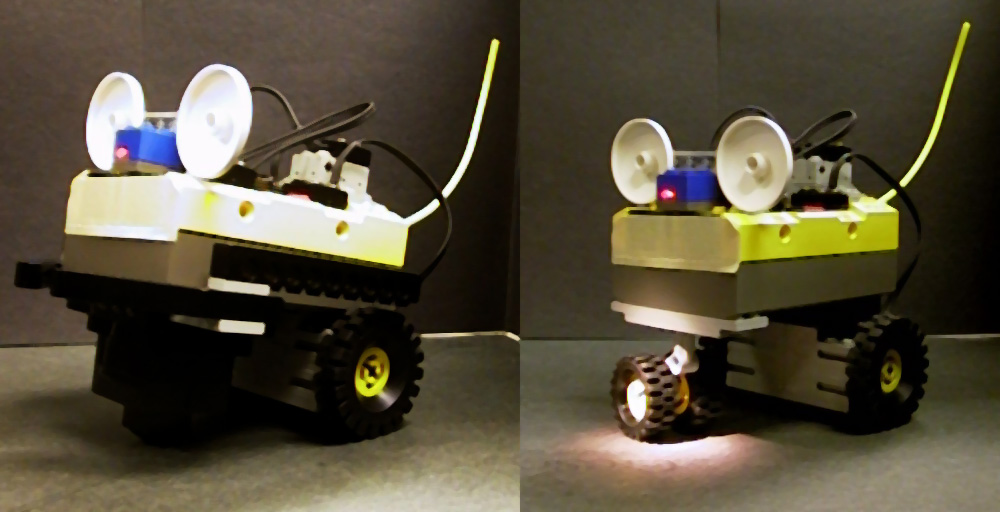Hardware
Throughout the entire development of Kraftmouse, our team experimented
with many different designs. The three main design prototypes, in the
order in which they were developed, included: a two light sensor
design, a two touch sensor design and a one light sensor design in
conjunction with infrared based Barrier Detection System (BDS).
Two Light Sensor Design
Initially in the design process, a two light sensor design seemed the
most obvious solution for our problem of navigating Kraftmouse out of
the corridor system. By using two light sensors positioned on the
front of Kraftmouse at 45 and 135 degrees, we postulated a plan to
exit the corridor by simply reading light intensity levels off the
surrounding walls. The theory behind this was that as Kraftmouse got
closer to a wall, the light being transmitted by the light sensor
would be reflected off the white walls thus producing a light
intensity level corresponding to a bright light level. The motor speed
on that side of Kraftmouse would have a speed proportional to the
intensity of the light recieved in reflection. Kraftmouse therefore
turn away from the closest wall, towards open space and ultimately to
a new home.
Unfortunately, as the lab progressed, so did the environment of the
corridor. More specifically the wall color. From a once white, very
reflective shade, the walls of the corridor were changed to an
extremely absorbing dark black shade in which our light reflection
system would not work. It seemed that with the black walls, an
insufficient amount of light was being reflected back to the light
sensor ultimately resulting in collisions and corner traps.
Two Touch Sensor System
Our second design prototype was a design comprising of a two touch
sensor system very similar to the original light sensor design. This
system worked very well at getting out of the corridor environment. We
then shifted focus on task two; new home detection using varying light
intensities. But in solving the problem of Task 2, the actual
searching for a new home depending on the signal received from the
transmitting RCX unit, we ended up in revamping the two-touch sensor
to a new design; an infrared system.
Barrier Detection System
This system evolved because of how we approached solving Task
2. Although ultimately it was not actually used in that portion of the
task. In order to solve Task 2 we postulated that with a system to
detect whether there was a building immediately infront of Kraftmouse
its light intensity level could be read and a decision on whether to
enter or not could be made.
The BDS system was adapted from sonar and radar system's used by many
Lego enthusiasts on the Internet. The basic function of these systems
are quite simple and Kraftmouse's implementation was very effective -
in ideal conditions it can detect obstructions more than a meter away
and it adapts very easily to changing light levels. When the RCX sends
an IR message it uses a series of IR pulses. Although these pulses may
seem insignificant to the human eye, they are in fact quite blinding
to the RCX's light sensor. Consider a situation where a barrier is
placed infront of the IR transimiter that will reflect the IR light
back at Kraftmouse's eye. If a series of light level samples are taken
over a relatively long period some will contain bright readings while
others would be dark. 200 miliseconds was more than sufficient. Remove
the barrier and there will be no light reflected back. A nice trick
for detecting buildings, barriers and other mousely concerns.
By developing this technology for KraftMouse, our team quickly
realized that the the two touch sensor design used to exit the
corridor system was redundant and were removed from the
mouse. Ultimately allowing KraftMouse to actually look more like a
mouse.
Free Wheel Design to a Skid Plate

Another hardware design modification done to Kraftmouse was that the
initial design for the propulsion mechanism consisted of two motors
and a pivoting two wheel support at the front, essentially a tricycle
design with the power to the two rear wheels. Through many trials, it
was concluded that the free rotating wheel supporting the front of
Kraftmouse was confounding its turning efforts. Causing Kraftmouse to
behave extremely unpredictably and also resulted in many situations
where Kraftmouse would get stuck against a wall and despite its best
efforts to turn around. Thus we improved this tricycle free-pivoting
wheel system by using a stabilizing peg on the front end with a
skid-plate at the bottom of the skid plate, a design adapted from
Pathfinder I.

